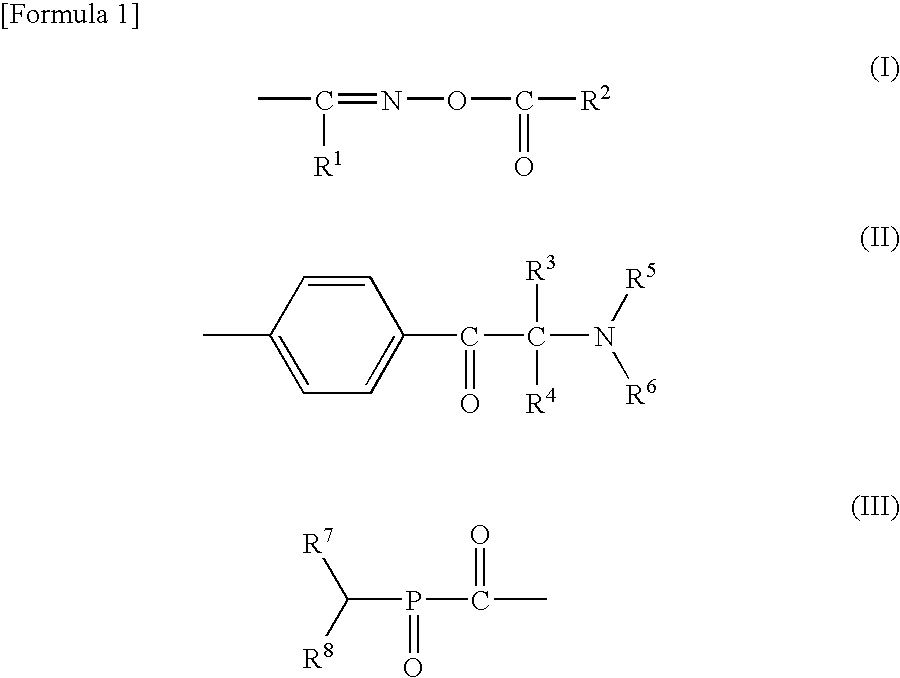Photocurable and thermosetting resin composition, cured product thereof and printed circuit board obtained using the same
a thermosetting resin and composition technology, applied in the field of photocurable and thermosetting resin composition, cured product thereof and printed circuit boards obtained using the same, can solve the problems of not being able to form a coating film, requiring a very long exposure time, and the application range of photocurable compositions containing conventional photopolymerization initiators is limited remarkably, so as to improve the initial productivity of printed circuit boards and improve the photocuring properties. , the effect of reducing th
- Summary
- Abstract
- Description
- Claims
- Application Information
AI Technical Summary
Benefits of technology
Problems solved by technology
Method used
Image
Examples
synthetic example 1
[0083] Into a 2 liter separable flask equipped with a stirrer, a thermometer, a reflux condenser, a dropping funnel, and a nitrogen introduction tube, 660 g of cresol novolak type epoxy resin (EOCN-104S produced by Nippon Kayaku Co., Ltd., a softening point: 92° C., an epoxy equivalent weight: 220), 421.3 g of carbitol acetate, and 180.6 g of solvent naphtha were charged. The mixture was heated and stirred at 90° C. until solution. The resin solution consequently obtained was cooled once to 60° C. The cooled solution and 216 g of acrylic acid, 4.0 g triphenyl phosphine, and 1.3 g of methyl hydroquinone added thereto were heated to 100° C. and left reacting for about 12 hours to obtain a reaction product having an acid value of 0.2 mg KOH / g. This reaction product and 241.7 g of tetrahydrophthalic anhydride added thereto were heated to 90° C. and left reacting for about 6 hours to obtain a solution of a carboxyl group-containing resin (A) having an acid value of 50 mg KOH / g, a double ...
synthetic example 2
[0084] Into a 2 liter separable flask equipped with a stirrer, a thermometer, a reflux condenser, a dropping funnel, and a nitrogen introduction tube, 430 g of an o-cresol novolak type epoxy resin (epoxy equivalent weight: 215, average number of phenol skeletons contained in its molecule: 6) and 144 g (2 mols) of acrylic acid were charged. The reaction mixture was heated to 120° C. while stirring, and the reaction was continued for 10 hours while keeping the temperature at 120° C. The reaction product consequently obtained was cooled once to room temperature. The cooled reaction product and 190 g (1.9 mols) of succinic anhydride added thereto were heated to 80° C. and left reacting for 4 hours. The resultant reaction product was again cooled to room temperature. The resultant reaction product had an acid value of 139 mg KOH / g.
[0085] This solution and 85.2 g (0.6 mol) of glycidyl methacrylate and 45.9 g of propylene glycol methyl ether acetate added thereto were heated to 110° C. wh...
synthetic example 3
[0086] Into a 2 liter separable flask equipped with a stirrer, a thermometer, a reflux condenser, a dropping funnel, and a nitrogen introduction tube, 215 parts of a cresol novolak type epoxy resin EPICLON N-680 (manufactured by Dainippon Ink and Chemicals Inc., epoxy equivalent weight: 215) was charged and then 266.5 parts of carbitol acetate was added thereto and they were molten by heating. To this resin solution, 0.05 part of hydroquinone as a polymerization inhibitor and 1.0 part of triphenyl phosphine as a reaction catalyst were added. The resultant mixture was heated to 85-95° C., 72 parts of acrylic acid was gradually added dropwise thereto, and they were left reacting for 24 hours. To the resultant epoxy acrylate, 208 parts of a half urethane obtained by the reaction of isophorone di-isocyanate and pentaerythritol triacrylate at the molar ratio of 1:1 in advance was gradually added dropwise, and the mixture was left reacting for 4 hours at 60-70° C. The varnish of the resul...
PUM
| Property | Measurement | Unit |
|---|---|---|
| maximum wavelength | aaaaa | aaaaa |
| maximum wavelength | aaaaa | aaaaa |
| maximum wavelength | aaaaa | aaaaa |
Abstract
Description
Claims
Application Information
 Login to View More
Login to View More - R&D
- Intellectual Property
- Life Sciences
- Materials
- Tech Scout
- Unparalleled Data Quality
- Higher Quality Content
- 60% Fewer Hallucinations
Browse by: Latest US Patents, China's latest patents, Technical Efficacy Thesaurus, Application Domain, Technology Topic, Popular Technical Reports.
© 2025 PatSnap. All rights reserved.Legal|Privacy policy|Modern Slavery Act Transparency Statement|Sitemap|About US| Contact US: help@patsnap.com



